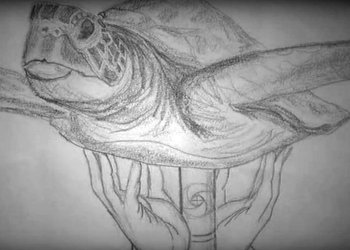Islanders and Sea Turtles have lived together for hundreds of years. Even before the 13th century, when New Zealand Aotearoa inhabitants first sailed from Rarotonga using ocean-going vaka, Pacific People and Sea Turtles shared the same waters, shores, and stars. Now, however, that peace is gone and honu is under siege and facing extinction.
Pollution
Many of the factors that undermine sea turtles well-being are not obvious to the casual eye. Plastic and garbage that fill our ocean waters choke the bodies of sea turtles when ingested. Unlike most other countries, the Cook Islanders take great pride in keeping the islands clean; weekly, if not daily, clean-ups take place. Unfortunately, as an oceanic nation, Cook Islanders are continually impacted by marine debris: most of this (>99%) is plastic waste that arrives from the industrialized world far away.
Industrialized Fishing
Industrialized fishing is permitted throughout the Cook Islands EEZ (2 million km2). License fees are the nation’s second largest source of revenue. Sea turtle bycatch (i.e. capture non-target species) is known to have an impact globally, but may be infrequent in these waters. Entangled in fishing lines that lace oceanic migration paths, nesting beaches, sea turtles die invisibly by the thousands.
Climate Change
Most sea turtle nesting nationally occurs on the sparsely-inhabited northern atolls. These are low-lying coralline islands that are at risk of being submerged from rising sea levels associated with global climate change.



 Sea turtles (honu) are long-lived, migratory marine reptiles exhibiting delayed maturity and iteroparous reproduction (i.e. sequential nests). They are aquatic animals that spend >99% of their lives at sea, surfacing only to breathe, and tied to land for egg-laying. Their navigational skills are remarkable, using geomagnetic cues, and there is good evidence to show that females return to the beach where they were born to lay their own eggs; it may take 40-50 years for a turtle to reach maturity (i.e. first reproduction).
Sea turtles (honu) are long-lived, migratory marine reptiles exhibiting delayed maturity and iteroparous reproduction (i.e. sequential nests). They are aquatic animals that spend >99% of their lives at sea, surfacing only to breathe, and tied to land for egg-laying. Their navigational skills are remarkable, using geomagnetic cues, and there is good evidence to show that females return to the beach where they were born to lay their own eggs; it may take 40-50 years for a turtle to reach maturity (i.e. first reproduction).
